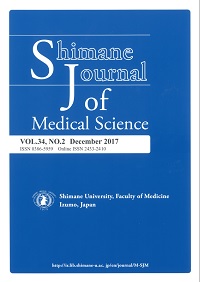Shimane University Faculty of Medicine
ISSN :0386-5959(冊子体)
ISSN :2433-2410(オンライン)


これらの論文は クリエイティブ・コモンズ 表示 - 非営利 - 改変禁止 4.0 国際 ライセンスの下に提供されています。
ダウンロード数 : ? 件
この文献の参照には次のURLをご利用ください : https://ir.lib.shimane-u.ac.jp/7580
Shimane Journal of Medical Science 28 1
2011-12-01 発行
Antimicrobial Activity of Natural Killer Cells and Lymphokine- Activated Killer Cells Against Mycobacterial Pathogens
ファイル
内容記述(抄録等)
We studied the antimicrobial activity of natural killer(NK)cells and lymphokine-activated killer (LAK)cells against Escherichia coli and some nontuberculous mycobacteria(NTM)including Mycobacterium fortuitum and Mycobacterium intracellulare.
When the antimicrobial activity of these cells was measured in terms of the number of residual colony forming units of test microorganisms, it was found that E. coli was rapidly killed by these effector cells during a 3-h coculture. NK cells and LAK cells exhibited comparable levels of bactericidal activity against E. coli. On the other hand, both the effector cells failed to exhibit microbicidal activity against M. fortuitum during 18 h of incubation. NK cells but not LAK cells displayed a mild inhibitory effect against M. fortuitum. Notably, LAK cells exhibited strong cytotoxicity against NK cell-susceptible YAC-1 cells compared to NK cells. Next, antimicrobial activity against mycobacteria was measured in terms of 3H-uracil uptake after an 18-h coculture with the effector cells. NK cells displayed similar levels of activity against M. fortuitum and M. intracellulare. The antimicrobial action against M. fortuitum was blocked by NK cell-specific antiasialo GM1 antibody. These findings indicate that NK cells but not LAK cells are capable of bacteriostatic activity against rapidly growing NTM(M. fortuitum)as well as slowly growing NTM(M. intracellulare), although these NTM are much more resistant to NK cells than E. coli.
When the antimicrobial activity of these cells was measured in terms of the number of residual colony forming units of test microorganisms, it was found that E. coli was rapidly killed by these effector cells during a 3-h coculture. NK cells and LAK cells exhibited comparable levels of bactericidal activity against E. coli. On the other hand, both the effector cells failed to exhibit microbicidal activity against M. fortuitum during 18 h of incubation. NK cells but not LAK cells displayed a mild inhibitory effect against M. fortuitum. Notably, LAK cells exhibited strong cytotoxicity against NK cell-susceptible YAC-1 cells compared to NK cells. Next, antimicrobial activity against mycobacteria was measured in terms of 3H-uracil uptake after an 18-h coculture with the effector cells. NK cells displayed similar levels of activity against M. fortuitum and M. intracellulare. The antimicrobial action against M. fortuitum was blocked by NK cell-specific antiasialo GM1 antibody. These findings indicate that NK cells but not LAK cells are capable of bacteriostatic activity against rapidly growing NTM(M. fortuitum)as well as slowly growing NTM(M. intracellulare), although these NTM are much more resistant to NK cells than E. coli.
About This Article
NCID
AA00841586
Other Article
Is it Possible to Predict the Onset of Side Effects in Patients Treated with Subcutaneous Buserelin?
PP. 21 - 26
PP. 27 - 34
